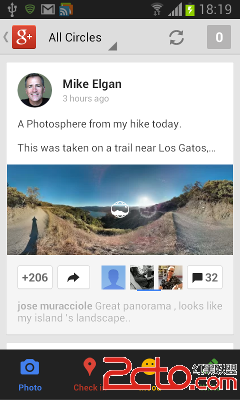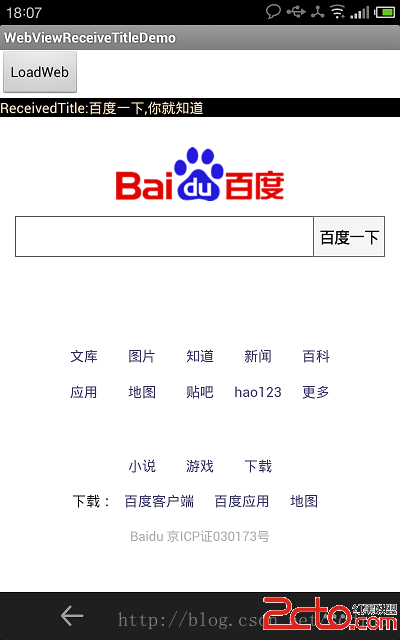編輯:關於Android編程
目標: 為四方體的每個面貼上一張圖片,並自動旋轉。
一、基礎知識:
要實現每個面上貼一張圖片,首先需要創建一個紋理,並使用圖片來生成一個紋理。
==========================================================================
1.初始化:
IntBuffer intBuffer = IntBuffer.allocate(2);
// 1.允許2D貼圖,紋理
gl.glEnable(GL10.GL_TEXTURE_2D);
// 2.創建紋理
gl.glGenTextures(2, intBuffer);
texture = intBuffer.get(0);
// 3.設置要使用的紋理
gl.glBindTexture(GL10.GL_TEXTURE_2D, texture);
// 4.生成紋理
GLUtils.texImage2D(GL10.GL_TEXTURE_2D, 0, GLImage.close_Bitmap, 0);
// 5.線形濾波
gl.glTexParameterx(GL10.GL_TEXTURE_2D, GL10.GL_TEXTURE_MIN_FILTER, GL10.GL_LINEAR);
gl.glTexParameterx(GL10.GL_TEXTURE_2D, GL10.GL_TEXTURE_MAG_FILTER, GL10.GL_LINEAR);
==========================================================================
2.使用:
// 1.清除屏幕和深度緩存
gl.glClear(GL10.GL_COLOR_BUFFER_BIT | GL10.GL_DEPTH_BUFFER_BIT);
// 2.重置當前的模型觀察矩陣
gl.glLoadIdentity();
// 3.移動到指定的位置
gl.glTranslatef(0.0f, 0.0f, -5.0f);
// 4.設置3個方向的旋轉
gl.glRotatef(xrot, 1.0f, 0.0f, 0.0f);
gl.glRotatef(yrot, 0.0f, 1.0f, 0.0f);
gl.glRotatef(zrot, 0.0f, 0.0f, 1.0f);
texture = intBuffer.get(1);;
// 5.綁定紋理
gl.glBindTexture(GL10.GL_TEXTURE_2D, texture);
// 6.開啟頂點和紋理功能
gl.glEnableClientState(GL10.GL_VERTEX_ARRAY);
gl.glEnableClientState(GL10.GL_TEXTURE_COORD_ARRAY);
// 7.紋理和四邊形對應的頂點
gl.glVertexPointer(3, GL10.GL_FIXED, 0, vertices);
gl.glTexCoordPointer(2, GL10.GL_FIXED, 0, texCoords);
// 8.繪制0
GLUtils.texImage2D(GL10.GL_TEXTURE_2D, 0, GLImage.iBitmap, 0);
gl.glDrawElements(GL10.GL_TRIANGLE_STRIP, 4, GL10.GL_UNSIGNED_BYTE, indices_0);
// 9.關閉頂點和紋理功能
gl.glDisableClientState(GL10.GL_TEXTURE_COORD_ARRAY);
gl.glDisableClientState(GL10.GL_VERTEX_ARRAY);
==========================================================================
二、實現:
1. 界面編輯:
【res\layout\main.xml】
[html]
<SPAN style="BACKGROUND-COLOR: #999999"><SPAN style="BACKGROUND-COLOR: #333333"><?xml version="1.0" encoding="utf-8"?>
<LinearLayout xmlns:android="http://schemas.android.com/apk/res/android"
android:orientation="vertical"
android:layout_width="fill_parent"
android:layout_height="fill_parent"
>
<TextView
android:layout_width="fill_parent"
android:layout_height="wrap_content"
android:text="@string/hello"
/>
<Button
android:id="@+id/button1"
android:layout_width="145dp"
android:layout_height="wrap_content"
android:text="演示開始" />
</LinearLayout>
</SPAN></SPAN>
<?xml version="1.0" encoding="utf-8"?>
<LinearLayout xmlns:android="http://schemas.android.com/apk/res/android"
android:orientation="vertical"
android:layout_width="fill_parent"
android:layout_height="fill_parent"
>
<TextView
android:layout_width="fill_parent"
android:layout_height="wrap_content"
android:text="@string/hello"
/>
<Button
android:id="@+id/button1"
android:layout_width="145dp"
android:layout_height="wrap_content"
android:text="演示開始" />
</LinearLayout>
2.代碼編輯:
【\src\com\yarin\android\Examples\Activity01.java】
[java]
package com.yarin.android.Examples_12_05;
import java.io.IOException;
import java.io.InputStream;
import javax.microedition.khronos.opengles.GL10;
import android.app.Activity;
import android.content.res.Resources;
import android.graphics.Bitmap;
import android.graphics.BitmapFactory;
import android.opengl.GLSurfaceView;
import android.opengl.GLUtils;
import android.opengl.GLSurfaceView.Renderer;
import android.os.Bundle;
import android.view.View;
import android.widget.Button;
public class Activity01 extends Activity
{
Renderer render = new GLRender();
GLSurfaceView glView;
Button start; // 演示開始
/** Called when the activity is first created. */
@Override
public void onCreate(Bundle savedInstanceState)
{
super.onCreate(savedInstanceState);
GLImage.load(this.getResources());
glView = new GLSurfaceView(this);
glView.setRenderer(render);
setContentView(R.layout.main);
start=(Button)findViewById(R.id.button1); // "演示開始"按鈕初始化
start.setOnClickListener(new View.OnClickListener() {
@Override
public void onClick(View v) {
// TODO Auto-generated method stub
setContentView(glView);
}
});
//setContentView(glView);
}
}
class GLImage
{
public static Bitmap iBitmap;
public static Bitmap jBitmap;
public static Bitmap kBitmap;
public static Bitmap lBitmap;
public static Bitmap mBitmap;
public static Bitmap nBitmap;
public static Bitmap close_Bitmap;
public static void load(Resources resources)
{
iBitmap = BitmapFactory.decodeResource(resources, R.drawable.img);
jBitmap = BitmapFactory.decodeResource(resources, R.drawable.jmg);
kBitmap = BitmapFactory.decodeResource(resources, R.drawable.kmg);
lBitmap = BitmapFactory.decodeResource(resources, R.drawable.lmg);
mBitmap = BitmapFactory.decodeResource(resources, R.drawable.mmg);
nBitmap = BitmapFactory.decodeResource(resources, R.drawable.nmg);
close_Bitmap = BitmapFactory.decodeResource(resources, R.drawable.close);
}
}
【\src\com\yarin\android\Examples\GLRender.java】
package com.yarin.android.Examples_12_05;
import java.io.IOException;
import java.io.InputStream;
import java.nio.ByteBuffer;
import java.nio.IntBuffer;
import javax.microedition.khronos.egl.EGLConfig;
import javax.microedition.khronos.opengles.GL10;
import android.graphics.Bitmap;
import android.graphics.BitmapFactory;
import android.opengl.GLUtils;
import android.opengl.GLSurfaceView.Renderer;
public class GLRender implements Renderer
{
float xrot, yrot, zrot;
int texture = -1;
int one = 0x10000;
IntBuffer intBuffer = IntBuffer.allocate(2);
int n_view_start_x=100;
int n_view_start_y=20;
int n_close_flag=0; // 1: close_icon show. 0: close_icon hide.
public int textureId;
IntBuffer vertices = IntBuffer.wrap(new int[]{
-one,-one,one,
one,-one,one,
one,one,one,
-one,one,one,
-one,-one,-one,
-one,one,-one,
one,one,-one,
one,-one,-one,
-one,one,-one,
-one,one,one,
one,one,one,
one,one,-one,
-one,-one,-one,
one,-one,-one,
one,-one,one,
-one,-one,one,
one,-one,-one,
one,one,-one,
one,one,one,
one,-one,one,
-one,-one,-one,
-one,-one,one,
-one,one,one,
-one,one,-one,
});
IntBuffer texCoords = IntBuffer.wrap(new int[]{
one,0,0,0,0,one,one,one,
0,0,0,one,one,one,one,0,
one,one,one,0,0,0,0,one,
0,one,one,one,one,0,0,0,
0,0,0,one,one,one,one,0,
one,0,0,0,0,one,one,one,
});
ByteBuffer indices = ByteBuffer.wrap(new byte[]{
0,1,3,2,
4,5,7,6,
8,9,11,10,
12,13,15,14,
16,17,19,18,
20,21,23,22,
});
ByteBuffer indices_0 = ByteBuffer.wrap(new byte[]{
0,1,3,2
});
ByteBuffer indices_1 = ByteBuffer.wrap(new byte[]{
4,5,7,6
});
ByteBuffer indices_2 = ByteBuffer.wrap(new byte[]{
8,9,11,10
});
ByteBuffer indices_3 = ByteBuffer.wrap(new byte[]{
12,13,15,14
});
ByteBuffer indices_4 = ByteBuffer.wrap(new byte[]{
16,17,19,18
});
ByteBuffer indices_5 = ByteBuffer.wrap(new byte[]{
20,21,23,22
});
//正方形的4個頂點
private IntBuffer quaterBuffer = IntBuffer.wrap(new int[]{
one,one,0,
-one,one,0,
one,-one,0,
-one,-one,0});
IntBuffer texCoords_rect = IntBuffer.wrap(new int[]{
0,1,1,1,1,0,0,0,
});
@Override
public void onDrawFrame(GL10 gl)
{
// 1.清除屏幕和深度緩存
gl.glClear(GL10.GL_COLOR_BUFFER_BIT | GL10.GL_DEPTH_BUFFER_BIT);
// 2.重置當前的模型觀察矩陣
gl.glLoadIdentity();
// 3.移動到指定的位置
gl.glTranslatef(0.0f, 0.0f, -5.0f);
// 4.設置3個方向的旋轉
gl.glRotatef(xrot, 1.0f, 0.0f, 0.0f);
gl.glRotatef(yrot, 0.0f, 1.0f, 0.0f);
gl.glRotatef(zrot, 0.0f, 0.0f, 1.0f);
texture = intBuffer.get(1);;
// 5.綁定紋理
gl.glBindTexture(GL10.GL_TEXTURE_2D, texture);
// 6.開啟頂點和紋理功能
gl.glEnableClientState(GL10.GL_VERTEX_ARRAY);
gl.glEnableClientState(GL10.GL_TEXTURE_COORD_ARRAY);
// 7.紋理和四邊形對應的頂點
gl.glVertexPointer(3, GL10.GL_FIXED, 0, vertices);
gl.glTexCoordPointer(2, GL10.GL_FIXED, 0, texCoords);
// 8.繪制0
GLUtils.texImage2D(GL10.GL_TEXTURE_2D, 0, GLImage.iBitmap, 0);
gl.glDrawElements(GL10.GL_TRIANGLE_STRIP, 4, GL10.GL_UNSIGNED_BYTE, indices_0);
//繪制1
GLUtils.texImage2D(GL10.GL_TEXTURE_2D, 0, GLImage.jBitmap, 0);
gl.glDrawElements(GL10.GL_TRIANGLE_STRIP, 4, GL10.GL_UNSIGNED_BYTE, indices_1);
//繪制2
GLUtils.texImage2D(GL10.GL_TEXTURE_2D, 0, GLImage.kBitmap, 0);
gl.glDrawElements(GL10.GL_TRIANGLE_STRIP, 4, GL10.GL_UNSIGNED_BYTE, indices_2);
//繪制3
GLUtils.texImage2D(GL10.GL_TEXTURE_2D, 0, GLImage.lBitmap, 0);
gl.glDrawElements(GL10.GL_TRIANGLE_STRIP, 4, GL10.GL_UNSIGNED_BYTE, indices_3);
//繪制4
GLUtils.texImage2D(GL10.GL_TEXTURE_2D, 0, GLImage.mBitmap, 0);
gl.glDrawElements(GL10.GL_TRIANGLE_STRIP, 4, GL10.GL_UNSIGNED_BYTE, indices_4);
//繪制5
GLUtils.texImage2D(GL10.GL_TEXTURE_2D, 0, GLImage.close_Bitmap, 0);
gl.glDrawElements(GL10.GL_TRIANGLE_STRIP, 4, GL10.GL_UNSIGNED_BYTE, indices_5);
if(0==n_close_flag)
{
// 重置當前的模型觀察矩陣
gl.glLoadIdentity();
// 左移 1.5 單位,並移入屏幕 5.0
gl.glTranslatef(-4.5f, 3.0f, -5.0f);
gl.glEnableClientState(GL10.GL_VERTEX_ARRAY);
gl.glEnableClientState(GL10.GL_TEXTURE_COORD_ARRAY);
texture = intBuffer.get(0);
// 綁定紋理
gl.glBindTexture(GL10.GL_TEXTURE_2D, texture);
GLUtils.texImage2D(GL10.GL_TEXTURE_2D, 0, GLImage.close_Bitmap, 0);
// 繪制關閉按鈕
// 設置和繪制正方形
gl.glVertexPointer(3, GL10.GL_FIXED, 0, quaterBuffer);
gl.glTexCoordPointer(2, GL10.GL_FIXED, 0, texCoords_rect);
gl.glDrawArrays(GL10.GL_TRIANGLE_STRIP, 0, 4);
//gl.glDrawElements(GL10.GL_TRIANGLE_STRIP, 4, GL10.GL_UNSIGNED_BYTE, indices_5);
n_close_flag=1;
}
// 9.關閉頂點和紋理功能
gl.glDisableClientState(GL10.GL_TEXTURE_COORD_ARRAY);
gl.glDisableClientState(GL10.GL_VERTEX_ARRAY);
xrot+=0.5f;
yrot+=0.6f;
zrot+=0.3f;
}
@Override
public void onSurfaceChanged(GL10 gl, int width, int height)
{
float ratio = (float) (width-n_view_start_x) / (height-n_view_start_x);
//設置OpenGL場景的大小
//gl.glViewport(0, 0, width, height);
gl.glViewport(n_view_start_x, n_view_start_y, width-n_view_start_x, height-n_view_start_y);
//設置投影矩陣
gl.glMatrixMode(GL10.GL_PROJECTION);
//重置投影矩陣
gl.glLoadIdentity();
// 設置視口的大小
gl.glFrustumf(-ratio, ratio, -1, 1, 1, 10);
// 選擇模型觀察矩陣
gl.glMatrixMode(GL10.GL_MODELVIEW);
// 重置模型觀察矩陣
gl.glLoadIdentity();
}
@Override
public void onSurfaceCreated(GL10 gl, EGLConfig config)
{
// 綠色背景
gl.glClearColor(0, 1, 0, 0);
gl.glEnable(GL10.GL_CULL_FACE);
// 啟用陰影平滑
gl.glShadeModel(GL10.GL_SMOOTH);
// 啟用深度測試
gl.glEnable(GL10.GL_DEPTH_TEST);
//啟用紋理映射
gl.glClearDepthf(1.0f);
//深度測試的類型
gl.glDepthFunc(GL10.GL_LEQUAL);
//精細的透視修正
gl.glHint(GL10.GL_PERSPECTIVE_CORRECTION_HINT, GL10.GL_NICEST);
/*
// 1.允許2D貼圖,紋理
gl.glEnable(GL10.GL_TEXTURE_2D);
IntBuffer intBuffer = IntBuffer.allocate(1);
// 2.創建紋理
gl.glGenTextures(1, intBuffer);
texture = intBuffer.get();
// 3.設置要使用的紋理
gl.glBindTexture(GL10.GL_TEXTURE_2D, texture);
// 4.生成紋理
GLUtils.texImage2D(GL10.GL_TEXTURE_2D, 0, GLImage.mBitmap, 0);
// 5.線形濾波
gl.glTexParameterx(GL10.GL_TEXTURE_2D, GL10.GL_TEXTURE_MIN_FILTER, GL10.GL_LINEAR);
gl.glTexParameterx(GL10.GL_TEXTURE_2D, GL10.GL_TEXTURE_MAG_FILTER, GL10.GL_LINEAR);
*/
// 1.允許2D貼圖,紋理
gl.glEnable(GL10.GL_TEXTURE_2D);
// 2.創建紋理
gl.glGenTextures(2, intBuffer);
texture = intBuffer.get(0);
// 3.設置要使用的紋理
gl.glBindTexture(GL10.GL_TEXTURE_2D, texture);
// 4.生成紋理
GLUtils.texImage2D(GL10.GL_TEXTURE_2D, 0, GLImage.close_Bitmap, 0);
texture = intBuffer.get(1);
// 3.設置要使用的紋理
gl.glBindTexture(GL10.GL_TEXTURE_2D, texture);
// 4.生成紋理
GLUtils.texImage2D(GL10.GL_TEXTURE_2D, 0, GLImage.nBitmap, 0);
// 5.線形濾波
gl.glTexParameterx(GL10.GL_TEXTURE_2D, GL10.GL_TEXTURE_MIN_FILTER, GL10.GL_LINEAR);
gl.glTexParameterx(GL10.GL_TEXTURE_2D, GL10.GL_TEXTURE_MAG_FILTER, GL10.GL_LINEAR);
}
}
package com.yarin.android.Examples_12_05;
import java.io.IOException;
import java.io.InputStream;
import javax.microedition.khronos.opengles.GL10;
import android.app.Activity;
import android.content.res.Resources;
import android.graphics.Bitmap;
import android.graphics.BitmapFactory;
import android.opengl.GLSurfaceView;
import android.opengl.GLUtils;
import android.opengl.GLSurfaceView.Renderer;
import android.os.Bundle;
import android.view.View;
import android.widget.Button;
public class Activity01 extends Activity
{
Renderer render = new GLRender();
GLSurfaceView glView;
Button start; // 演示開始
/** Called when the activity is first created. */
@Override
public void onCreate(Bundle savedInstanceState)
{
super.onCreate(savedInstanceState);
GLImage.load(this.getResources());
glView = new GLSurfaceView(this);
glView.setRenderer(render);
setContentView(R.layout.main);
start=(Button)findViewById(R.id.button1); // "演示開始"按鈕初始化
start.setOnClickListener(new View.OnClickListener() {
@Override
public void onClick(View v) {
// TODO Auto-generated method stub
setContentView(glView);
}
});
//setContentView(glView);
}
}
class GLImage
{
public static Bitmap iBitmap;
public static Bitmap jBitmap;
public static Bitmap kBitmap;
public static Bitmap lBitmap;
public static Bitmap mBitmap;
public static Bitmap nBitmap;
public static Bitmap close_Bitmap;
public static void load(Resources resources)
{
iBitmap = BitmapFactory.decodeResource(resources, R.drawable.img);
jBitmap = BitmapFactory.decodeResource(resources, R.drawable.jmg);
kBitmap = BitmapFactory.decodeResource(resources, R.drawable.kmg);
lBitmap = BitmapFactory.decodeResource(resources, R.drawable.lmg);
mBitmap = BitmapFactory.decodeResource(resources, R.drawable.mmg);
nBitmap = BitmapFactory.decodeResource(resources, R.drawable.nmg);
close_Bitmap = BitmapFactory.decodeResource(resources, R.drawable.close);
}
}
【\src\com\yarin\android\Examples\GLRender.java】
package com.yarin.android.Examples_12_05;
import java.io.IOException;
import java.io.InputStream;
import java.nio.ByteBuffer;
import java.nio.IntBuffer;
import javax.microedition.khronos.egl.EGLConfig;
import javax.microedition.khronos.opengles.GL10;
import android.graphics.Bitmap;
import android.graphics.BitmapFactory;
import android.opengl.GLUtils;
import android.opengl.GLSurfaceView.Renderer;
public class GLRender implements Renderer
{
float xrot, yrot, zrot;
int texture = -1;
int one = 0x10000;
IntBuffer intBuffer = IntBuffer.allocate(2);
int n_view_start_x=100;
int n_view_start_y=20;
int n_close_flag=0; // 1: close_icon show. 0: close_icon hide.
public int textureId;
IntBuffer vertices = IntBuffer.wrap(new int[]{
-one,-one,one,
one,-one,one,
one,one,one,
-one,one,one,
-one,-one,-one,
-one,one,-one,
one,one,-one,
one,-one,-one,
-one,one,-one,
-one,one,one,
one,one,one,
one,one,-one,
-one,-one,-one,
one,-one,-one,
one,-one,one,
-one,-one,one,
one,-one,-one,
one,one,-one,
one,one,one,
one,-one,one,
-one,-one,-one,
-one,-one,one,
-one,one,one,
-one,one,-one,
});
IntBuffer texCoords = IntBuffer.wrap(new int[]{
one,0,0,0,0,one,one,one,
0,0,0,one,one,one,one,0,
one,one,one,0,0,0,0,one,
0,one,one,one,one,0,0,0,
0,0,0,one,one,one,one,0,
one,0,0,0,0,one,one,one,
});
ByteBuffer indices = ByteBuffer.wrap(new byte[]{
0,1,3,2,
4,5,7,6,
8,9,11,10,
12,13,15,14,
16,17,19,18,
20,21,23,22,
});
ByteBuffer indices_0 = ByteBuffer.wrap(new byte[]{
0,1,3,2
});
ByteBuffer indices_1 = ByteBuffer.wrap(new byte[]{
4,5,7,6
});
ByteBuffer indices_2 = ByteBuffer.wrap(new byte[]{
8,9,11,10
});
ByteBuffer indices_3 = ByteBuffer.wrap(new byte[]{
12,13,15,14
});
ByteBuffer indices_4 = ByteBuffer.wrap(new byte[]{
16,17,19,18
});
ByteBuffer indices_5 = ByteBuffer.wrap(new byte[]{
20,21,23,22
});
//正方形的4個頂點
private IntBuffer quaterBuffer = IntBuffer.wrap(new int[]{
one,one,0,
-one,one,0,
one,-one,0,
-one,-one,0});
IntBuffer texCoords_rect = IntBuffer.wrap(new int[]{
0,1,1,1,1,0,0,0,
});
@Override
public void onDrawFrame(GL10 gl)
{
// 1.清除屏幕和深度緩存
gl.glClear(GL10.GL_COLOR_BUFFER_BIT | GL10.GL_DEPTH_BUFFER_BIT);
// 2.重置當前的模型觀察矩陣
gl.glLoadIdentity();
// 3.移動到指定的位置
gl.glTranslatef(0.0f, 0.0f, -5.0f);
// 4.設置3個方向的旋轉
gl.glRotatef(xrot, 1.0f, 0.0f, 0.0f);
gl.glRotatef(yrot, 0.0f, 1.0f, 0.0f);
gl.glRotatef(zrot, 0.0f, 0.0f, 1.0f);
texture = intBuffer.get(1);;
// 5.綁定紋理
gl.glBindTexture(GL10.GL_TEXTURE_2D, texture);
// 6.開啟頂點和紋理功能
gl.glEnableClientState(GL10.GL_VERTEX_ARRAY);
gl.glEnableClientState(GL10.GL_TEXTURE_COORD_ARRAY);
// 7.紋理和四邊形對應的頂點
gl.glVertexPointer(3, GL10.GL_FIXED, 0, vertices);
gl.glTexCoordPointer(2, GL10.GL_FIXED, 0, texCoords);
// 8.繪制0
GLUtils.texImage2D(GL10.GL_TEXTURE_2D, 0, GLImage.iBitmap, 0);
gl.glDrawElements(GL10.GL_TRIANGLE_STRIP, 4, GL10.GL_UNSIGNED_BYTE, indices_0);
//繪制1
GLUtils.texImage2D(GL10.GL_TEXTURE_2D, 0, GLImage.jBitmap, 0);
gl.glDrawElements(GL10.GL_TRIANGLE_STRIP, 4, GL10.GL_UNSIGNED_BYTE, indices_1);
//繪制2
GLUtils.texImage2D(GL10.GL_TEXTURE_2D, 0, GLImage.kBitmap, 0);
gl.glDrawElements(GL10.GL_TRIANGLE_STRIP, 4, GL10.GL_UNSIGNED_BYTE, indices_2);
//繪制3
GLUtils.texImage2D(GL10.GL_TEXTURE_2D, 0, GLImage.lBitmap, 0);
gl.glDrawElements(GL10.GL_TRIANGLE_STRIP, 4, GL10.GL_UNSIGNED_BYTE, indices_3);
//繪制4
GLUtils.texImage2D(GL10.GL_TEXTURE_2D, 0, GLImage.mBitmap, 0);
gl.glDrawElements(GL10.GL_TRIANGLE_STRIP, 4, GL10.GL_UNSIGNED_BYTE, indices_4);
//繪制5
GLUtils.texImage2D(GL10.GL_TEXTURE_2D, 0, GLImage.close_Bitmap, 0);
gl.glDrawElements(GL10.GL_TRIANGLE_STRIP, 4, GL10.GL_UNSIGNED_BYTE, indices_5);
if(0==n_close_flag)
{
// 重置當前的模型觀察矩陣
gl.glLoadIdentity();
// 左移 1.5 單位,並移入屏幕 5.0
gl.glTranslatef(-4.5f, 3.0f, -5.0f);
gl.glEnableClientState(GL10.GL_VERTEX_ARRAY);
gl.glEnableClientState(GL10.GL_TEXTURE_COORD_ARRAY);
texture = intBuffer.get(0);
// 綁定紋理
gl.glBindTexture(GL10.GL_TEXTURE_2D, texture);
GLUtils.texImage2D(GL10.GL_TEXTURE_2D, 0, GLImage.close_Bitmap, 0);
// 繪制關閉按鈕
// 設置和繪制正方形
gl.glVertexPointer(3, GL10.GL_FIXED, 0, quaterBuffer);
gl.glTexCoordPointer(2, GL10.GL_FIXED, 0, texCoords_rect);
gl.glDrawArrays(GL10.GL_TRIANGLE_STRIP, 0, 4);
//gl.glDrawElements(GL10.GL_TRIANGLE_STRIP, 4, GL10.GL_UNSIGNED_BYTE, indices_5);
n_close_flag=1;
}
// 9.關閉頂點和紋理功能
gl.glDisableClientState(GL10.GL_TEXTURE_COORD_ARRAY);
gl.glDisableClientState(GL10.GL_VERTEX_ARRAY);
xrot+=0.5f;
yrot+=0.6f;
zrot+=0.3f;
}
@Override
public void onSurfaceChanged(GL10 gl, int width, int height)
{
float ratio = (float) (width-n_view_start_x) / (height-n_view_start_x);
//設置OpenGL場景的大小
//gl.glViewport(0, 0, width, height);
gl.glViewport(n_view_start_x, n_view_start_y, width-n_view_start_x, height-n_view_start_y);
//設置投影矩陣
gl.glMatrixMode(GL10.GL_PROJECTION);
//重置投影矩陣
gl.glLoadIdentity();
// 設置視口的大小
gl.glFrustumf(-ratio, ratio, -1, 1, 1, 10);
// 選擇模型觀察矩陣
gl.glMatrixMode(GL10.GL_MODELVIEW);
// 重置模型觀察矩陣
gl.glLoadIdentity();
}
@Override
public void onSurfaceCreated(GL10 gl, EGLConfig config)
{
// 綠色背景
gl.glClearColor(0, 1, 0, 0);
gl.glEnable(GL10.GL_CULL_FACE);
// 啟用陰影平滑
gl.glShadeModel(GL10.GL_SMOOTH);
// 啟用深度測試
gl.glEnable(GL10.GL_DEPTH_TEST);
//啟用紋理映射
gl.glClearDepthf(1.0f);
//深度測試的類型
gl.glDepthFunc(GL10.GL_LEQUAL);
//精細的透視修正
gl.glHint(GL10.GL_PERSPECTIVE_CORRECTION_HINT, GL10.GL_NICEST);
/*
// 1.允許2D貼圖,紋理
gl.glEnable(GL10.GL_TEXTURE_2D);
IntBuffer intBuffer = IntBuffer.allocate(1);
// 2.創建紋理
gl.glGenTextures(1, intBuffer);
texture = intBuffer.get();
// 3.設置要使用的紋理
gl.glBindTexture(GL10.GL_TEXTURE_2D, texture);
// 4.生成紋理
GLUtils.texImage2D(GL10.GL_TEXTURE_2D, 0, GLImage.mBitmap, 0);
// 5.線形濾波
gl.glTexParameterx(GL10.GL_TEXTURE_2D, GL10.GL_TEXTURE_MIN_FILTER, GL10.GL_LINEAR);
gl.glTexParameterx(GL10.GL_TEXTURE_2D, GL10.GL_TEXTURE_MAG_FILTER, GL10.GL_LINEAR);
*/
// 1.允許2D貼圖,紋理
gl.glEnable(GL10.GL_TEXTURE_2D);
// 2.創建紋理
gl.glGenTextures(2, intBuffer);
texture = intBuffer.get(0);
// 3.設置要使用的紋理
gl.glBindTexture(GL10.GL_TEXTURE_2D, texture);
// 4.生成紋理
GLUtils.texImage2D(GL10.GL_TEXTURE_2D, 0, GLImage.close_Bitmap, 0);
texture = intBuffer.get(1);
// 3.設置要使用的紋理
gl.glBindTexture(GL10.GL_TEXTURE_2D, texture);
// 4.生成紋理
GLUtils.texImage2D(GL10.GL_TEXTURE_2D, 0, GLImage.nBitmap, 0);
// 5.線形濾波
gl.glTexParameterx(GL10.GL_TEXTURE_2D, GL10.GL_TEXTURE_MIN_FILTER, GL10.GL_LINEAR);
gl.glTexParameterx(GL10.GL_TEXTURE_2D, GL10.GL_TEXTURE_MAG_FILTER, GL10.GL_LINEAR);
}
}
 Android點贊動畫效果 ,點贊後加一,2種方法,①補間動畫②位移動畫
Android點贊動畫效果 ,點贊後加一,2種方法,①補間動畫②位移動畫
第一個動畫文件btn_anim.xml 2-在res文件夾 anim文件夾下面,建立第二個文件layout_anim.xml):
 Android實現Banner界面廣告圖片循環輪播(包括實現手動滑動循環)
Android實現Banner界面廣告圖片循環輪播(包括實現手動滑動循環)
前言:經常會看到有一些app的banner界面可以實現循環播放多個廣告圖片和手動滑動循環。本以為單純的ViewPager就可以實現這些功能。但是蛋疼的事情來了
 Android源碼編譯的環境搭建
Android源碼編譯的環境搭建
由於Google編譯Android源碼使用的操作系統是Ubuntu,所以此處本人也是安裝Ubuntu操作系統。五筆法安裝Ubuntu系統固然方便簡單,可缺陷是安裝的系統的
 Android WebChromeClient
Android WebChromeClient
主程序: public class WebPageLoader extends Activity{ final Activity activit